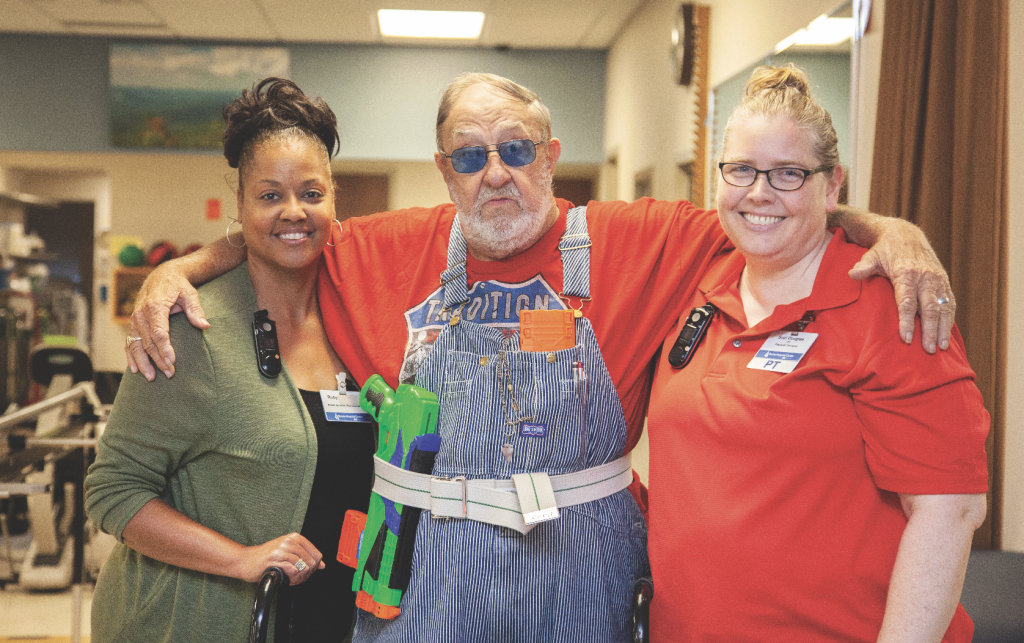
ON TARGET
By Erin Wegner
Larry Springer loves the outdoors. Whether he’s hunting, fishing or camping with his wife Kathy, if he’s outdoors, he’s happy. His love for hunting started at 14, and he enjoys hunting pheasants, squirrels and rabbits. He looks forward to November every year when he can pheasant hunt with his two bird dogs – an English Pointer named Duke and a Brittany named Bonnie. Both dogs have been part of Larry’s pack for 3 years, and he loves hunting with them.
In November 2018, Larry noticed he was having pain in his right leg. He was a little concerned, but he had already planned a trip to spend Thanksgiving with his sister in Florida. This would be Kathy’s first trip to the beach, so even though his pain was still present, Larry was looking forward to this trip. Unfortunately, while they were in Florida, Larry noticed his pain had started to get worse.
After returning home, Larry scheduled a visit with his physician. There he found out he had two blood clots in his right leg. Next he scheduled an appointment with a surgeon where he learned the hard truth; there was too much damage done to his leg, and they wouldn’t be able to save it. He was now faced with preparing himself for an amputation. This came as a complete shock to Larry as he never thought they wouldn’t be able to save his leg. Larry had his right leg amputated above the knee in December 2018.
After his surgery, Larry met Michael Darby, CP, of Darby Orthotics and Prosthetics, who got Larry measured for his prosthetic. Larry got an endoskeletal above knee prosthesis.
“When I make an above knee prosthetic, I tend to make something that is relatively easy for them to get on and off and one that is relatively safe,” says Darby.
Larry’s prosthesis allows him to wear tennis shoes and has a strap that holds it on. But once he is done with therapy, he may choose to use a prosthetic that is more complicated. Darby explains, “The feet [for the prosthetic] are very specific to the patient’s activities, as well as their height and weight.”
To learn how to walk and use his prosthetic, Larry has been working with Suzanne Douglas, a Physical Therapist at Boone Therapy, the hospital’s outpatient rehabilitation service. Larry’s therapy includes walking, climbing stairs and exercises to help him put more weight on his prosthetic.
“It can be extremely difficult for individuals with lower limb amputations to place faith and trust into their new prosthetic limbs, to know it will be there to support them,” Suzanne explains.
Right now, Larry is able to walk with the help of a walker, but is unable to walk on his own yet. While therapy is helping Larry get adjusted to this new way of life, his ultimate goal is to be able to walk on his own and get back to pheasant hunting with his dogs.
“Imagine standing on a lower limb that you aren’t able to fully feel or sense,” Suzanne says. “Relearning to walk with a prosthetic limb is challenging and difficult, and those going through this training should be commended.”
One way Boone Therapy helps Larry prepare for his goal of returning to his hunting lifestyle – some of his therapy sessions include shooting a Nerf gun at targets while he stands on foam, to simulate uneven ground outside.
Through this experience, Larry has kept his sense of humor. He admits that shooting targets with a Nerf gun can be challenging, because they don’t have the best aim, but he can still joke. “I don’t know why they won’t let me bring my real guns in here,” he says with a smile.
“Physical therapy focuses on presenting our amputee clients with challenges that may lie ahead with use of their prosthetic limb,” says Suzanne. She adds that the goal is to help people like Larry achieve “functional ambulation,” or the ability to walk with an assistive device.
When asked about his favorite part of therapy, Larry says fondly that it’s definitely the people. He says with a smile, “They’re so friendly. I love them all.”
When asked about what part of therapy has been the hardest for him, he very calmly says, “Nothing. I’m not a quitter.”
Boone Therapy has also helped Larry work on his progress at home. He makes sure he spends time each day walking. He’s able to stand at the sink to wash dishes, and he still does all the cooking, which he loves.
Larry looks forward to being able to return to pheasant hunting. Until then, he still enjoys spending time outside,